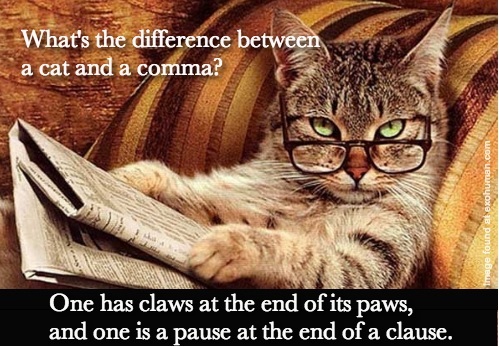Commas: Don’t Go Comma-Kaze!

Or should I say, comma crazy? One of the most frequent punctuation errors is over-use of the comma. Other punctuation is easier to use because the rules are easier to define and understand. The comma, however, can be a bit of an enigma.
Here are some simple rules to help you master the proper use of the comma.
Rule one: (This one is the easiest) Use a comma after each item in a list.
I need to buy apples, cereal, diapers, chicken, juice, toothpaste, and soup.
Notice that there is also a comma before the word “and” because toothpaste is an item in the list and so therefore should be followed by a comma.
Rule two: Use a comma after an introductory phrase.
Although he is only 17, he is wise beyond his years.
The first half of the sentence introduces the second half. To make this easier, here is a tip: an introduction cannot stand alone, but the rest of the sentence can. Without the introduction, you could still say, “He is wise beyond his years.”

Rule three: Commas are used to separate opposing, conflicting or changing ideas.
He wants to pass his exam, but he refuses to study.
Mexico is really cheap this time of year, however, staying home is even cheaper.
It’s freezing outside, yet he insists on wearing a t-shirt.
In these sentences, two complete thoughts are tied together by a comma and a conjunction (or “connector” word). Without the comma and the conjunction, you would have two shorter sentences:
He wants to pass the exam. He refuses to study.
Rule four: Commas indicate an interruption in thought.
Have you ever started to speak and then were reminded of a detail that you needed to add as you were speaking? Commas can do the same thing.
His favorite car, a 1957 Chevy, was destroyed in a tornado.
Her oldest sister, Janice, comes to visit often.
Both sentences are still correct without the added detail.
His favorite car was destroyed in a tornado.
Her oldest sister comes to visit often.
Rule five: A comma helps direct a comment to the person you are addressing.
Julie, hand me the pliers.
Do you, Peter, take this woman?
In the next example, comma use is crucial. Omitting the comma would give you an entirely different sentence.
Let’s eat, Grandpa! might be a rather unsettling thought without the comma.
Let’s eat Grandpa!
Rule six: Commas separate the parts of dates, addresses, personal titles, long numbers, and greetings.
He was born July 16, 2005.
The new office is located at 25 Cherry Street, London, England.
Hello, I’m John Smith, Director of Operations.
The mayor won by 34,500 votes.
The asking price on that house is $235,000.
Rule seven: Use a comma before quotation ( “ ” ) marks or inside the closing quotation mark. (Punctuation that is part of speech is always contained within quotation marks.)
“You’re really pretty,” he said.
He said, “Wow, you’re really pretty.”
“Thanks,” she replied, “You’re cute, too.”
Rule eight: If in doubt, a comma may indicate a pause.
In all the rules except for rules six and seven, a comma can coincide with a pause. If a pause would not be acceptable in speech, it probably would not be an appropriate place for a comma. Here are some examples where I have substituted a pause for a comma.
Paul (pause) what is your favorite movie?
Come to think of it (pause) I haven’t seen him lately.
Dear Mom (pause) please send money.
If we pool our resources (pause) the job will get done faster.
There are many other more subtle rules for the use of commas, but these are the most important. Overuse of the comma can result in clumsy, disjointed writing that is confusing and difficult to read. If you’re still not sure, under-use of the comma is a far more forgiving error.
